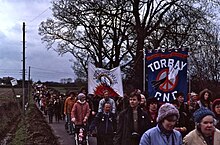Hard Rock (exercise)
[8] The attack scenario for the previous simulation, the 1980 Square Leg exercise, had been leaked to the press and the Campaign for Nuclear Disarmament (CND).
[9] This scenario envisaged more than 200 megatons of nuclear weapons being detonated on the country, a quantity in line with other British civil defence exercises conducted in the 1970s and advice in the Home Office's training manual for scientific advisors, issued in 1977.
[10] The public response to the projected high casualty rates and widespread destruction had been poor so the Hard Rock planners deliberately assumed an attack scenario with fewer weapons, totalling less than 50 megatons, and avoiding strikes on some obvious targets such as American air bases.
He notes other political decisions affected the exercise: the scale of refugee movements was toned down and references to civil disorder were kept vague.
A war with the Soviet Union was to have broken out at 4:30 am on 27 September with an invasion of West Germany and conventional air raids on the UK.
During this time, the military had a limited role to play in the exercise, simulating reconnaissance flights over nuclear target areas and practising moving ships in and out of ports scheduled to remain unaffected.
The exercise included decisions made to triage casualties by likelihood of survival, with those affected by severe radiation sickness left to die without food or treatment, and the prioritisation of resources on those healthy adults with skills necessary to keep remaining infrastructure working.
[15] Refusals were largely in local authorities controlled by the Labour Party, with some using it as an opportunity to demonstrate their opposition to the defence policies of the Conservative government.
[4] As part of its opposition to Hard Rock, the Greater London Council invited the public to view its secret nuclear bunkers, intended for post-attack command by civil defence personnel, with 4,800 people visiting them in six days.
[18] Had the exercise gone ahead protestors planned to establish peace camps outside the regional seats of government from which civil defence operations would be co-ordinated.
[4] The CND's Scottish secretary Ian Davison called it the organisation's first major victory and Peter Byrd, a writer on the history of the peace movement, described the cancellation as "probably [its] biggest single success".
These compelled local authorities to support national civil defence exercises and imposed financial penalties for them and individual councillors if they did not comply.
The regulations also gave the government the power to appoint special commissioners to run the exercises within the local authorities.

